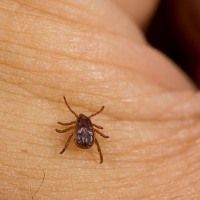Ehrlichiosis Ill From the Bite of Blood-Sucking Ticks

Ehrlichiosis is a bacterial disease transmitted by ticks. The signs and symptoms of ehrlichiosis ranging from mild to severe body aches and fever that appear within a week or two weeks after a tick bite.
If treated quickly with antibiotics, ehrlichiosis generally improves within a few days. The best way to prevent infection is to avoid tick bites.
Symptom
If lice carriers of bacteria that cause ehrlichiosis have been biting for 24 hours, the signs and symptoms below may appear within five to 14 days after the bite:
Mild fever, headache, muscle pain, nausea, vomiting, diarrhea, cough, rash, Confusion
Some people infected with ehrlichiosis may have symptoms so mild they do not need to seek medical help and the body can fight the disease itself. But untreated ehrlichiosis with persistent symptoms can cause serious illness and require hospitalization.
The Cause
Ehrlichiosis caused by Ehrlichia chaffeensis bacteria transmitted by ticks and Lone Star. Ticks attached to the host and drink the blood of its host to swell several times their normal size. During the meal, bacteria carrying ticks can transmit the bacteria to host a healthy, or be able to take up the bacteria if parent already infected. Ehrlichiosis occurs when the body was bitten by an infected flea. The bacteria enter the skin through bites and flowing in the bloodstream. Before bacteria can be transmitted, must be attached ticks and blood drinking for at least 24 hours. A fleas and ticks indicate that the already swollen eating long enough to transmit the bacteria. Disposing of ticks can prevent infection as soon as possible. Ehrlichiosis can be transmitted through blood transfusions, from mother to fetus, and through direct contact with infected animals.
treatments and medicines
If the doctor suspects a person is exposed ehrlichiosis or other diseases caused by tick bites, the doctor will prescribe an antibiotic such as doxycycline or tetracycline. Antibiotics are usually used for seven to ten days later there were signs and symptoms begin to subside within two days. Your doctor may prescribe antibiotics for a longer period if there is the possibility of Lyme disease infection as well. For pregnant women, doctors may prescribe an antibiotic revamping vice versa, because tetracycline and doxycycline is not recommended during pregnancy.